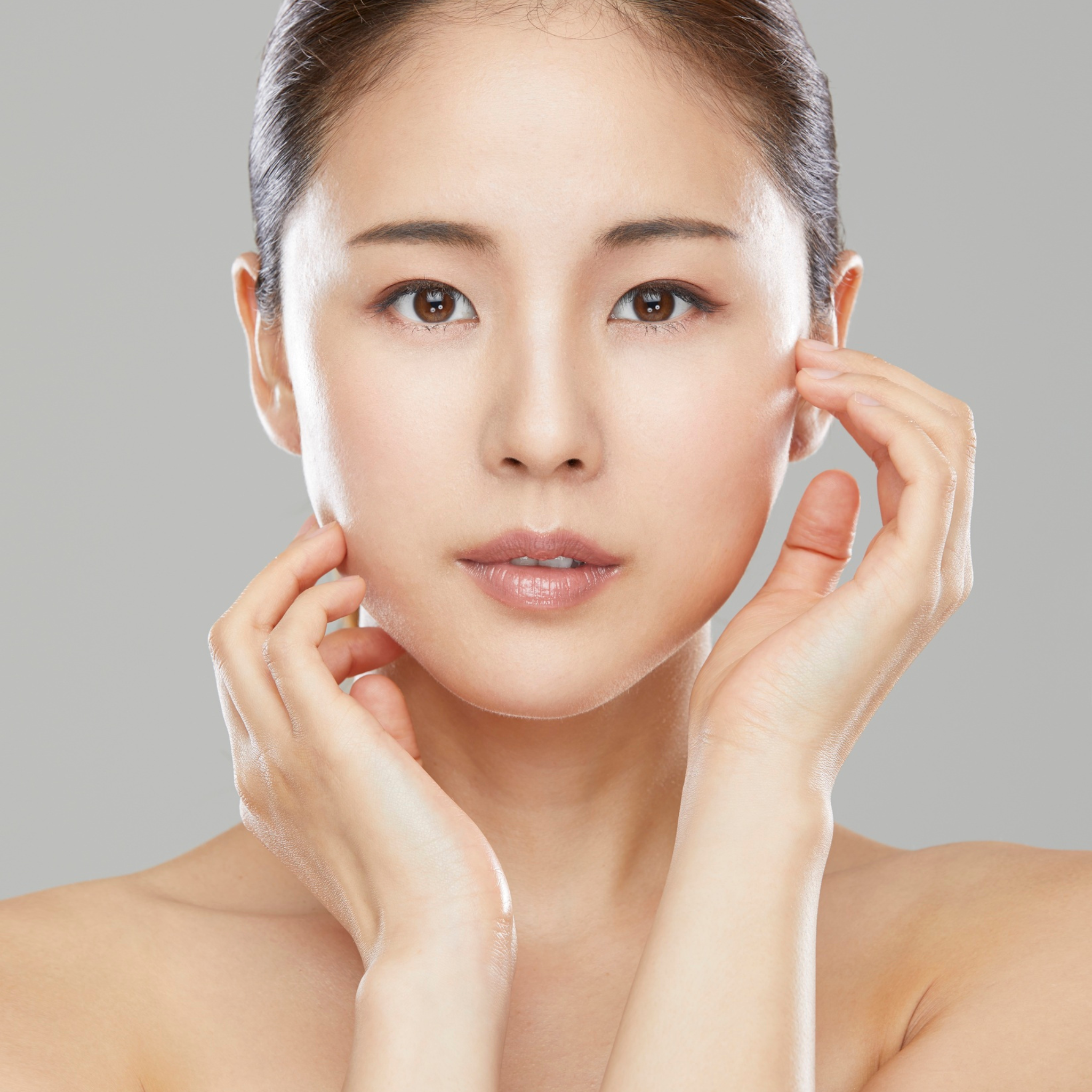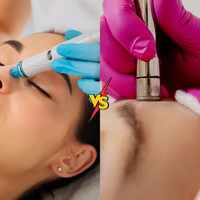As time passes, our skin naturally begins to lose its firmness and elasticity. Fine lines, sagging cheeks, and a less-defined jawline often become noticeable signs of aging. This happens mainly due to a gradual decline in collagen and elastin, the proteins responsible for keeping skin plump and tight.
Nowadays, you have countless anti-aging options from high-tech skin treatments like RF (radiofrequency) tightening to anti-aging creams that promise firmer, smoother skin. But which one actually delivers visible, lasting results?
If you’re wondering whether to invest in professional RF sessions or rely on skincare creams, this comprehensive guide breaks down how each works, what to expect, and which may be better suited to your skin goals.
Skin Tightening and Collagen
Collagen is a protein responsible for keeping your skin firm, elastic, and youthful. Collagen is the most abundant protein in your body, making up about 30% of total body protein. It serves as the foundation of your skin, muscles, bones, tendons, ligaments, and other connective tissues. You’ll also find it in your organs, blood vessels, and intestinal lining.
This structural protein is formed from three main amino acids: proline, glycine, and hydroxyproline, which coil together in a triple-helix structure. To create this helix, your body also needs vitamin C, zinc, copper, and manganese, which act as essential cofactors for collagen synthesis.
In the skin, collagen gives strength and elasticity while supporting fibroblasts, the cells responsible for producing new tissue. It also plays a key role in replacing dead skin cells and maintaining the integrity of the dermis, the middle layer of the skin.
After the age of 25, collagen production gradually declines by about 1 - 2% each year, leading to wrinkles, fine lines, and sagging. Lifestyle factors like sun exposure, smoking, and poor diet can further accelerate this process.
Both RF skin tightening and firming creams target this collagen loss to restore firmness and elasticity, but they work differently.
● RF skin tightening stimulates collagen remodeling deep in the dermis using controlled heat.
● Firming creams work more superficially, using peptides, retinoids, and antioxidants to nourish and support collagen renewal at the skin’s surface.
The Main Types of Collagen and Their Roles
Although scientists have identified 28 types of collagen, five major types are most important for your skin and connective tissues. Each type plays a distinct role in maintaining your body’s structure and strength.
● Type I: The most abundant form, making up around 90% of your body’s collagen. It’s densely packed and provides strength to skin, bones, tendons, and ligaments.
● Type II: Found mainly in elastic cartilage, it supports joint flexibility and smooth movement.
● Type III: Found in muscles, arteries, and organs, it maintains structural integrity and elasticity in soft tissues.
● Type IV: Found in the basement membrane of the skin, it forms the foundation for different skin layers and helps regenerate skin cells.
● Type V: Present in the cornea, hair, and placenta, this type helps build and maintain skin structure and tissue development.
Understanding these collagen types helps explain why certain skin treatments like RF skin tightening can deliver deeper, longer-lasting results than topical options. While creams nourish and protect the upper layers of the skin, RF energy triggers collagen remodeling within the dermis, strengthening these underlying structures from the inside out.
RF Skin Tightening
Radiofrequency (RF) skin tightening is a non-surgical aesthetic treatment designed to lift and firm loose or sagging skin, helping you achieve a smoother, more youthful appearance.
Radio frequency devices deliver safe, low-frequency electromagnetic waves that generate controlled heat beneath the skin’s surface. This thermal energy penetrates deep into the dermal layers, where it stimulates cellular renewal and encourages the production of collagen and elastin, two vital proteins responsible for the skin’s firmness, elasticity, and strength.
As these structural proteins rebuild over time, the skin gradually becomes tighter, more resilient, and noticeably rejuvenated, restoring its natural lift and contour without surgery or downtime.
Types of RF Treatments
Monopolar RF
Monopolar (or unipolar) RF systems use a single electrode to deliver radiofrequency energy into the skin. The electrical current travels from this electrode through the targeted area, generating heat within the deeper layers. A grounding pad is placed elsewhere on the patient’s body to safely return the current to the device and complete the circuit. This method allows energy to penetrate more deeply, making it effective for tightening and contouring larger treatment areas.
Bipolar RF
Bipolar RF technology uses two electrodes built into the handpiece. The current passes directly between these two points, heating the tissue in a more localized and controlled manner. Since the circuit is completed within the handpiece itself, the energy doesn’t travel through the rest of the body. This makes bipolar RF ideal for delicate areas and surface-level tightening.
Fractional RF
Fractional RF represents the latest generation of radiofrequency therapy. It combines traditional RF energy with microneedling technology, creating tiny, controlled micro-injuries in the skin. These microchannels trigger the body’s natural wound-healing response, boosting collagen and elastin production while improving skin texture, tone, and firmness.
Treatment Areas
● Face (cheeks, forehead, jawline)
● Neck and chin
● Eyes and brow area
● Abdomen and thighs
RF treatments can be performed at a dermatologist’s office or at home using FDA-approved RF devices.
Benefits of RF Skin Tightening
Radiofrequency (RF) skin tightening offers results comparable to a facelift (rhytidectomy), but without surgery or long downtime. Some of its standout benefits include:
● Subtle, natural-looking improvements that develop gradually over time.
● Quick and comfortable treatment sessions with minimal discomfort.
● More affordable and less invasive than traditional cosmetic surgeries.
● No risk of peeling or scarring, unlike some laser or chemical treatments.
● Little to no recovery time, allowing you to return to work and daily activities right away.
Skin Tightening Creams
Skin-tightening creams are among the most popular noninvasive options for achieving smoother, younger-looking skin. A wide range of products is available on the market, each formulated with unique active ingredients designed to improve firmness, elasticity, or overall texture.
For instance, tretinoin creams (a prescription-strength form of vitamin A) work by stimulating collagen production and accelerating skin renewal. Similarly, retinol-based firming creams encourage both collagen and elastin synthesis, gently resurfacing the outer skin layer for a more toned appearance.
While both types can help reduce sagging and slow visible aging, identifying the right combination of ingredients for your skin type can be challenging.
Key Ingredients in Skin Tightening Creams
Some of the most effective and scientifically supported components in skin-tightening creams include:
● Retinol (Vitamin A): A fat-soluble derivative of vitamin A known for its anti-aging and skin-renewing benefits. Retinol enhances cell turnover, stimulates collagen, and refines texture by exfoliating dead skin cells from the surface.
● Tretinoin (Retinoic Acid): A prescription-strength retinoid that delivers more potent results than over-the-counter retinol. Available in varying concentrations, tretinoin accelerates skin cell regeneration, reduces wrinkles, and treats acne, giving the skin a smoother and firmer look.
● Hyaluronic Acid: A naturally occurring molecule found in the skin, joints, and eyes, it acts as a powerful humectant, drawing moisture into cells and plumping the skin for improved firmness and hydration.
● Vitamin E: A fat-soluble antioxidant that protects against free radical damage, supports moisture retention, and encourages cell repair. Regular use can help fade dark spots, reduce fine lines, and strengthen the skin barrier.
Together, these ingredients work synergistically to make the skin look tighter, smoother, and more resilient over time, all without the need for invasive procedures.
RF Skin Tightening vs Creams
|
Feature |
RF Skin Tightening |
Skin Tightening Creams |
|
Depth of Action |
Targets deep dermal layers |
Acts on the surface and upper dermis |
|
Collagen Stimulation |
Clinically proven to boost collagen and elastin |
Mild stimulation via topical absorption |
|
Result Timeline |
Noticeable improvement within weeks; continues for months |
Gradual improvement with consistent use |
|
Longevity of Results |
Lasts 6–12 months or longer |
Temporary; requires daily reapplication |
|
Safety |
Safe when done by professionals |
Generally safe; depends on ingredients |
|
Downtime |
Minimal (mild redness or warmth) |
None |
|
Cost |
$150–$1000 per session |
$30–$150 per product |
|
Ideal Candidate |
Moderate to severe laxity |
Mild laxity, early aging prevention |
When to Choose RF Skin Tightening
RF skin tightening is ideal for those experiencing visible sagging or moderate skin laxity. You may be a good candidate if you notice:
● Drooping along the jawline or under the chin
● Loose skin on the neck or cheeks
● Fine lines around the mouth or eyes
● Post-weight-loss or postpartum skin laxity
Pros: noticeable tightening, collagen regeneration, and long-lasting firmness.
Cons: higher cost, requires professional expertise, and multiple sessions.
Avoid RF if you have:
● Pacemakers or metal implants
● Pregnancy or breastfeeding
● Active skin infections or open wounds
When to Choose Skin Tightening Creams
If your concerns are mild or you’re in your 20s – 30s, firming creams can help maintain youthful skin and delay sagging.
Best For:
● Early signs of skin aging
● Preventive care and hydration
● Maintenance after RF or laser treatments
Choose creams with clinically proven actives (like peptides, retinol, or niacinamide) and always apply sunscreen daily, as UV exposure accelerates collagen loss.
Dermatologists suggest using firming creams alongside antioxidant serums to enhance repair and protection.
Can You Combine RF Treatments with Creams?
Yes, and it’s often the best strategy for long-term results.
● RF stimulates collagen from deep within.
● Creams protect, hydrate, and nourish the skin barrier on the surface.
Post-RF Care Recommendations
● Use gentle, hydrating creams or serums containing hyaluronic acid, ceramides, or peptides.
● Avoid exfoliating acids or retinol for 48–72 hours post-treatment to prevent irritation.
● Apply broad-spectrum sunscreen daily to preserve your results.
Combining both methods creates a synergistic effect; RF builds the foundation, while creams maintain and enhance it.
Takeaway
There’s no one-size-fits-all answer in the debate of RF skin tightening vs creams. If your goal is visible, deep rejuvenation, and contouring, radiofrequency technology delivers results beyond what topical products can achieve. However, if you’re looking for gentle, affordable maintenance or prevention, firming creams remain a great option.
The most effective approach often combines both RF to rebuild collagen and creams to preserve hydration and barrier health. Always consult a board-certified dermatologist before starting any new treatment plan to ensure it suits your skin type, age, and sensitivity level.
Consistent care, sun protection, and collagen support, whether through technology or topicals, are the keys to truly youthful, resilient skin.








0 comments